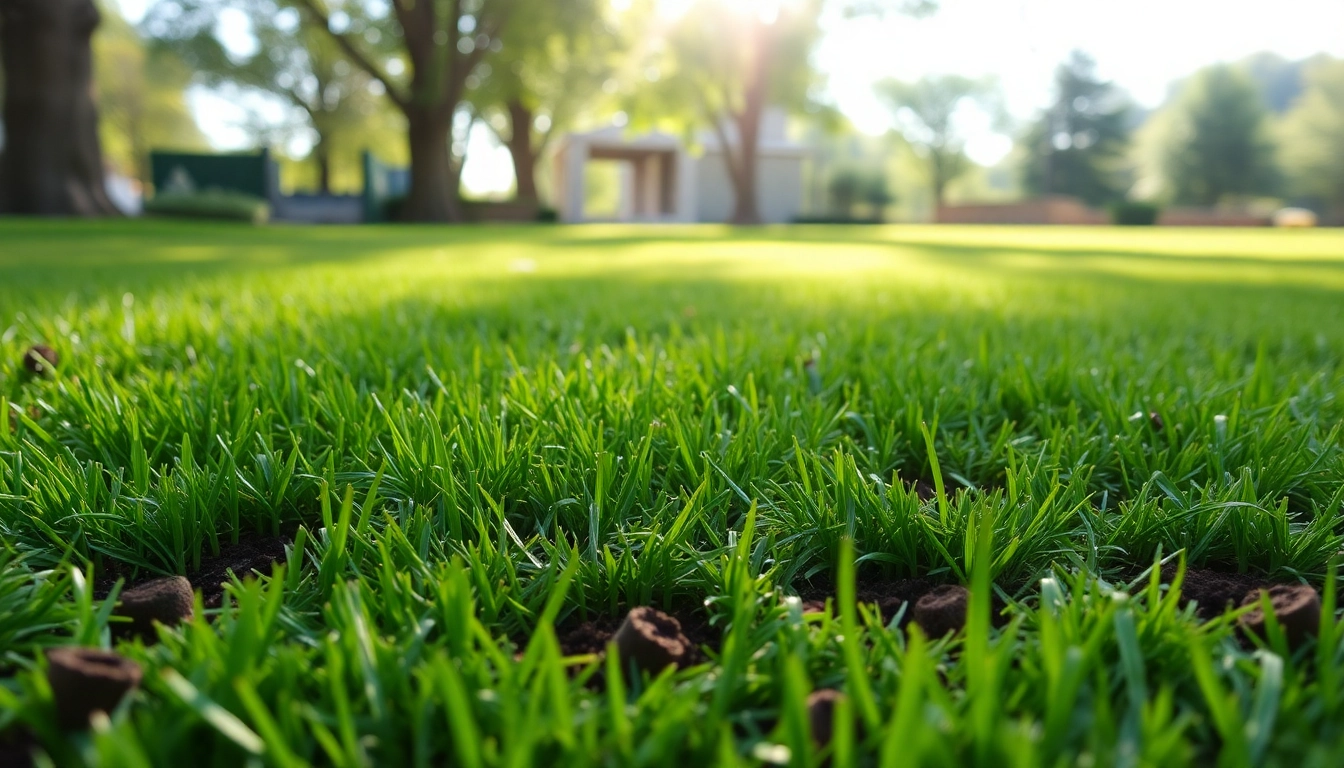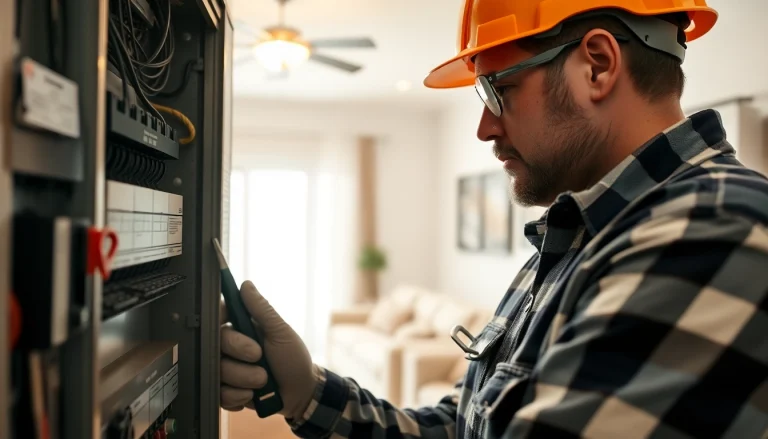
Understanding Core Aeration
What Is Core Aeration?
Core aeration is a beneficial lawn care technique that involves the removal of small plugs, or “cores,” of soil from the lawn using a specialized machine known as a lawn aerator. This process enables improved air circulation, water infiltration, and nutrient absorption by alleviating soil compaction, which can stifle healthy grassroots growth. By creating holes—typically around ½ to ¾ of an inch in diameter—core aeration directly enhances the conditions needed for a lush, green lawn.
Benefits of Core Aeration for Your Lawn
The benefits of core aeration are multifaceted, particularly for homeowners who are keen on maintaining a vibrant lawn. Here are some key advantages:
- Improved Soil Structure: Aeration breaks up compacted soil, leading to a better overall structure that promotes root growth.
- Enhanced Nutrient Uptake: With less compaction, the soil more readily absorbs fertilizers and other nutrients, improving lawn health.
- Increased Airflow: The holes created during aeration allow for improved oxygen flow to the root system, which is vital for grass health.
- Better Water Infiltration: Aerated lawns can absorb rainfall and irrigation more effectively, reducing runoff and water pooling.
- Thatch Reduction: Aeration helps in breaking down thatch—a layer of dead grass and organic matter—promoting healthier grass growth.
When to Perform Core Aeration
Timing is crucial when it comes to core aeration. It’s best to aerate your lawn during its peak growing seasons—early spring or fall for cool-season grasses, and late spring through early summer for warm-season varieties. Performing aeration at these times allows the grass to recover quickly and take advantage of the improved conditions.
Additionally, consider aerating if your lawn receives heavy foot traffic, shows signs of compaction, or has a layer of thatch exceeding half an inch.
Types of Aeration Techniques
Comparing Core Aeration with Spike Aeration
Core aeration and spike aeration represent two primary methods of aerating the lawn. While both aim to alleviate soil compaction, they employ different techniques:
- Core Aeration: As previously mentioned, this method removes soil plugs, improving airflow and moisture retention in the lawn. The removal of soil cores prevents soil compaction from worsening over time.
- Spike Aeration: This method involves creating holes in the soil by driving spikes into it without removing any material. Spike aeration can lead to even more compaction around the holes created, as soil is merely displaced rather than extracted.
For a long-term solution to soil compaction and a healthier lawn, core aeration is generally the preferred method.
Liquid Aeration: A Modern Alternative
Liquid aeration is a newer method gaining popularity in lawn care. This technique involves spraying a liquid product that claims to penetrate compaction zones, allowing water, nutrients, and air to reach the root zone without the need for mechanical processes. Some benefits include ease of application and less disruption to the lawn compared to traditional aeration methods.
However, while liquid aeration can improve the soil’s condition temporarily, it may not replace the substantial benefits that core aeration provides if the soil is significantly compacted. Always consider your specific lawn conditions before deciding on a technique.
Choosing the Right Method for Your Lawn
Determining whether to use core aeration, spike aeration, or liquid aeration depends on several factors:
- Soil Condition: For severely compacted or clay-heavy soils, core aeration is often the most effective solution.
- Cost and Convenience: Liquid aeration may offer a less labor-intensive option, though it can be more costly over time.
- Lawn Usage: Heavily trafficked lawns benefit significantly from the deeper penetration of core aeration.
Before proceeding, assess your lawn’s condition and your goals to make an informed decision.
DIY Core Aeration: Step-by-Step Guide
Equipment Needed for Core Aeration
To perform core aeration, you will need the following equipment:
- Lawn Aerator: A gas or electric-powered machine designed specifically for core aeration. Many home improvement stores offer rental options for these machines.
- Rake: To spread any soil plugs back into the lawn afterward, or to collect them if desired.
- Grass Seed (if overseeding): This is optional, but overseeding can be a great complement to aeration.
- Watering Equipment: A hose or sprinkler system for post-aeration watering.
Preparation Steps for Effective Aeration
Prior to aerating your lawn, follow these preparation steps:
- Mow the Lawn: Cut your grass to a shorter height (about 2-3 inches), which makes the aeration more effective.
- Water the Lawn: Lightly water the lawn a day or two before aeration. The moisture will help the aerator penetrate the soil more effectively.
- Identify Problem Areas: Pay special attention to areas of heavy compaction or thinning grass.
- Mark Obstacles: Be sure to mark irrigation heads or any other underground obstructions to avoid damaging them during the aeration process.
Post-Aeration Lawn Care Tips
After aerating your lawn, proper care is essential to maximize its effectiveness. Here are some post-aeration tips:
- Leave Soil Plugs: Allow the soil plugs to remain on the lawn. They will decompose and return nutrients to the soil.
- Watering: Water the lawn deep after aeration to help the grass recover. Aim for about an inch of water to penetrate the soil.
- Fertilization: Consider applying a starter fertilizer to enhance grass recovery and growth.
- Overseeding: If needed, overseed the lawn to fill in bare spots and encourage thicker grass growth.
Common Questions About Core Aeration
How Often Should I Core Aerate?
The frequency of core aeration largely depends on your lawn’s condition—consider aerating every one to two years for lawns with heavy foot traffic, while less-trafficked lawns can benefit from aeration every two to four years.
Does Core Aeration Really Work?
Yes, core aeration is effective in promoting a healthier lawn. Studies indicate that it can improve air exchange, water uptake, and nutrient absorption in grass, leading to a denser, greener yard.
Myths and Facts About Core Aeration
Many misconceptions surround the practice of core aeration. For example, it is commonly believed that aerating can cause too much disruption to the lawn. However, with proper execution, core aeration significantly enhances a lawn’s health without causing long-term damage.
Hiring a Professional for Core Aeration
When to Consider Professional Aeration Services
If you’re unsure about performing core aeration yourself or have a large lawn, it may be wise to hire professional services. Professionals have the necessary equipment and experience to ensure effective aeration.
Finding the Right Lawn Care Service
When searching for lawn care services, consider the following:
- Experience: Look for companies with positive reviews and experienced staff.
- Certifications: Verified professionals often have the necessary certifications to guarantee quality work.
- Estimates: Obtain multiple quotes to ascertain competitive pricing for core aeration services.
Cost of Core Aeration Services
Pricing for core aeration services can vary based on several factors including lawn size and local market rates. Typically, homeowners should expect to spend anywhere from $100 to $300; larger lawns may cost more. It’s advisable to ask for detailed quotes from different service providers to find the best fit for your budget.






